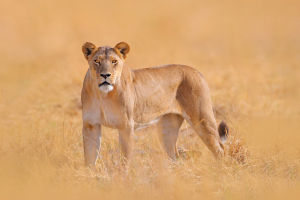The red fox, the largest species in the genus Vulpes, is widely distributed in many regions of the Northern Hemisphere. Red foxes are named for their bright orange-red fur.
They are highly adaptable animals that can survive in a variety of habitats, including forests, grasslands, wetlands, farmlands, and even urban areas. Their success is largely due to their excellent hunting skills, flexible eating habits, and amazing endurance.
Red Fox: The Skilled and Cunning Hunter
Video by Wild Matters
Red foxes are usually between 45 and 90 cm long, with a tail length of about 30 to 55 cm, and their weight generally ranges from 3 to 14 kg. Their size varies slightly from region to region, and red foxes in cold areas are usually larger, while red foxes in warm areas are relatively smaller. The red fox's tail (also known as "fox fur") is particularly dense, helping them keep warm on cold nights. The tail is also an important tool for its balance.
The red fox can use its tail to keep its body stable when running fast. In addition, the tail can also be used for social interactions with other foxes. The white tip of the tail is a typical feature of the red fox. Red foxes can come in a variety of colors, from classic orange-red to gray and even black. Although they are best known for their typical red fur, they can adapt to different environments to better hide. For example, in colder areas, red foxes tend to have lighter fur, while in more forested areas, their fur tends to be darker.
Red foxes are highly intelligent and alert animals. They have very keen eyesight, smell, and hearing, especially hearing, which allows them to detect the faint sounds of prey below the ground. Red foxes are very flexible in their hunting methods.
They mainly feed on small mammals, such as rabbits and rodents, but they are also opportunists and can adjust their diet according to the environment and food supply. In addition to meat, red foxes will eat fruits, berries, insects, and even carrion.
They can use a variety of food sources in their environment to survive, and this diverse diet strategy is also key to their ability to thrive in multiple habitats.
Red foxes hunt with skill and intelligence. They usually approach their prey quietly, using their long and sensitive ears to locate the prey. Red foxes are known for their signature high leaps to pounce on prey, a move that not only allows them to surprise small animals hiding in the grass or snow but also ensures a high success rate. After a successful hunt, red foxes often store excess food for future use. This behavior shows that red foxes are not just improvisational predators, but also have a certain ability to plan and reserve.
Red foxes occupy an important position in human culture. In many legends, myths, and literary works, red foxes are often portrayed as cunning and resourceful. For example, in European folklore, foxes are often described as cunning animals that can outwit other animals and even humans.
However, red foxes are not always welcome. In some areas, especially those with developed animal husbandry, red foxes are considered a threat because they sometimes attack poultry and small livestock. Therefore, human attitudes towards red foxes are often complicated. On the one hand, they are charming and intelligent wild animals, and on the other hand, they are also regarded as pets. In some countries, red foxes have also become targets of hunting.
Fox hunting was once very popular in the UK and other parts of Europe, although in recent years this sport has been increasingly criticized and opposed by animal protection groups. Red foxes are a formidable species whose intelligence, hunting skills, and adaptability make them a presence that cannot be ignored in nature. As the largest and most widespread species in the genus Vulpes, red foxes demonstrate the diversity and tenacious will to survive that nature has given to life.


